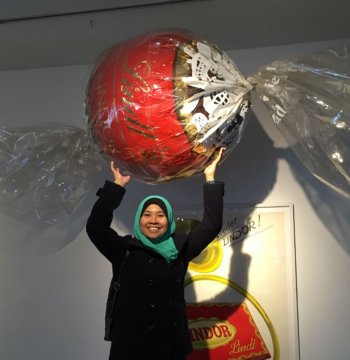an experimental study on friction and adhesion between single aramid fibres
Nurhidayah Binti Ismail is a PhD student in the Department of Mechanics of Solids, Surfaces & Systems (MS3). His supervisor is dr.ir. M.B. de Rooij from the Faculty of Engineering Technology (ET).
 Friction and adhesion properties between fibres is of great importance as it affects both the physical and mechanical performance of end products made from these fibres. At micro and nanoscale, friction and adhesion phenomena are driven primarily by a high volume-to surface ratio. Thus, understanding the mechanism of friction and adhesion between fibres is needed, for example to predict the mechanical behaviour of composites or fibrous structures. This thesis therefore addresses fundamental knowledge of the friction and adhesion behaviour between single aramid fibres.
Friction and adhesion properties between fibres is of great importance as it affects both the physical and mechanical performance of end products made from these fibres. At micro and nanoscale, friction and adhesion phenomena are driven primarily by a high volume-to surface ratio. Thus, understanding the mechanism of friction and adhesion between fibres is needed, for example to predict the mechanical behaviour of composites or fibrous structures. This thesis therefore addresses fundamental knowledge of the friction and adhesion behaviour between single aramid fibres.
A review of the experimental approach concerning friction and adhesion between single fibres is presented. It is shown that the principle of the linear motion method is the most suitable method that can be adapted to develop an experimental setup for measuring the friction and adhesion between single fibres.
Since the contribution of the surface physical properties is one of the important factors influencing the friction and adhesion, the wetting and surface energy of single aramid fibre is also studied. The surface energy is determined from the dynamic contact angle measurements using Wilhelmy’s method. It is shown that the surface energy of aramid fibres is polar in character, exhibiting hydrophilic behaviour.
The influence of the parameters such as pre-tension load, fibre orientation (crossing angle), normal load and elastic modulus on the friction force is studied. A taut wire model is used to formulate the contact length between contacting fibre surfaces in perpendicular contact. With this model, the deflection of the fibre as well as the contact intimacy between fibres can be calculated and related to the measured friction force. However, it is found that the ‘wrapping effect’ due to pre-tension is small in comparison with the elastic deformation in contact. In an elliptical contact, it is found the role of pre-tension is relatively small and friction and contact area between fibres are dominated by the effect of fibre orientation (crossing angle). Generally the friction force decreases as the crossing angle increases. The Hertzian elliptical contact model is used to explain the changing size of the contact area due to the fibre orientations. Assuming the interfacial strength at the contact area is constant, the predicted friction force is in agreement with the measured friction force.
Further, the adhesion force between single fibres is explained using experiments and models. The effect of relative humidity and fibre orientation (crossing angle) on adhesion force is determined. At a relative humidity of 50%, the adhesion force shows a significant increase. The Young- Laplace and Kelvin equations are used to predict the adhesion force. At very low humidity levels (~8%), the adhesion force is reducing with increasing crossing angle. The contribution of the contact area due to the crossing angle effect is assessed using the JKR elliptical adhesive contact model. The experimental data fits with the model by considering the roughness effect as a scaling factor. However, in ambient conditions (~40% relative humidity), the adhesion force shows a minimum value at about 40° crossing angle due to the capillary torque.
In short, friction and adhesion between single aramid fibres have been explored successfully. Studies show that the role of the contact area between two contacting fibres is highly important in influencing the friction and adhesion force values.

